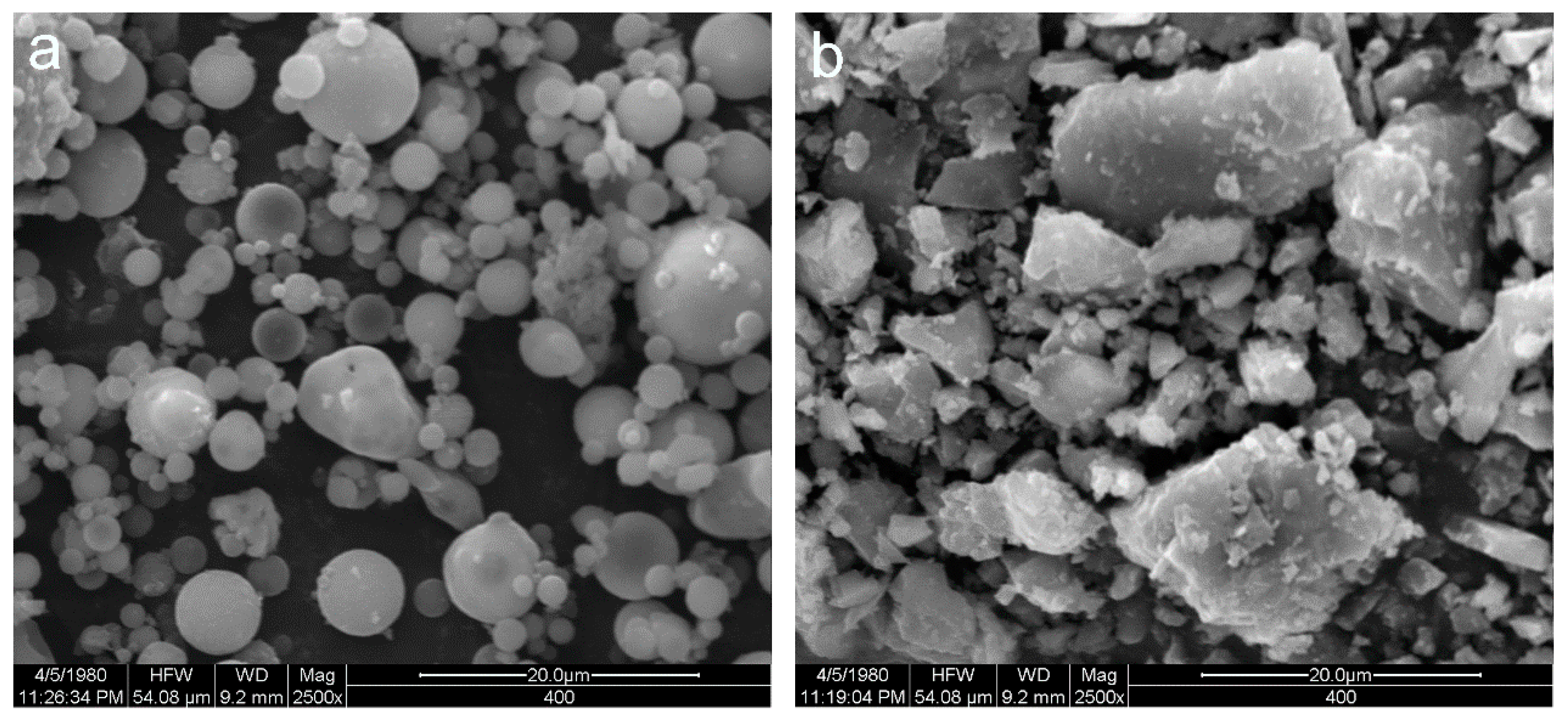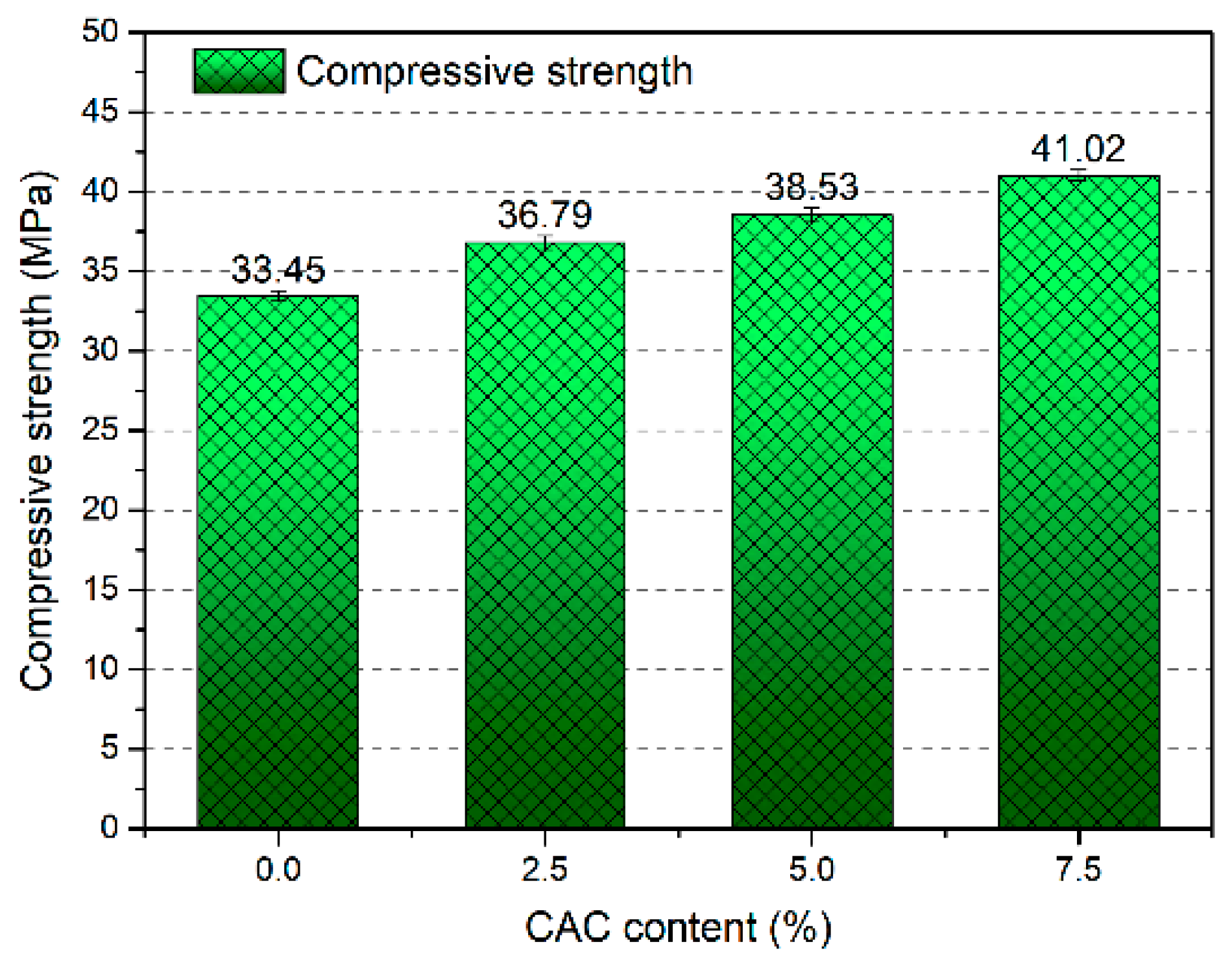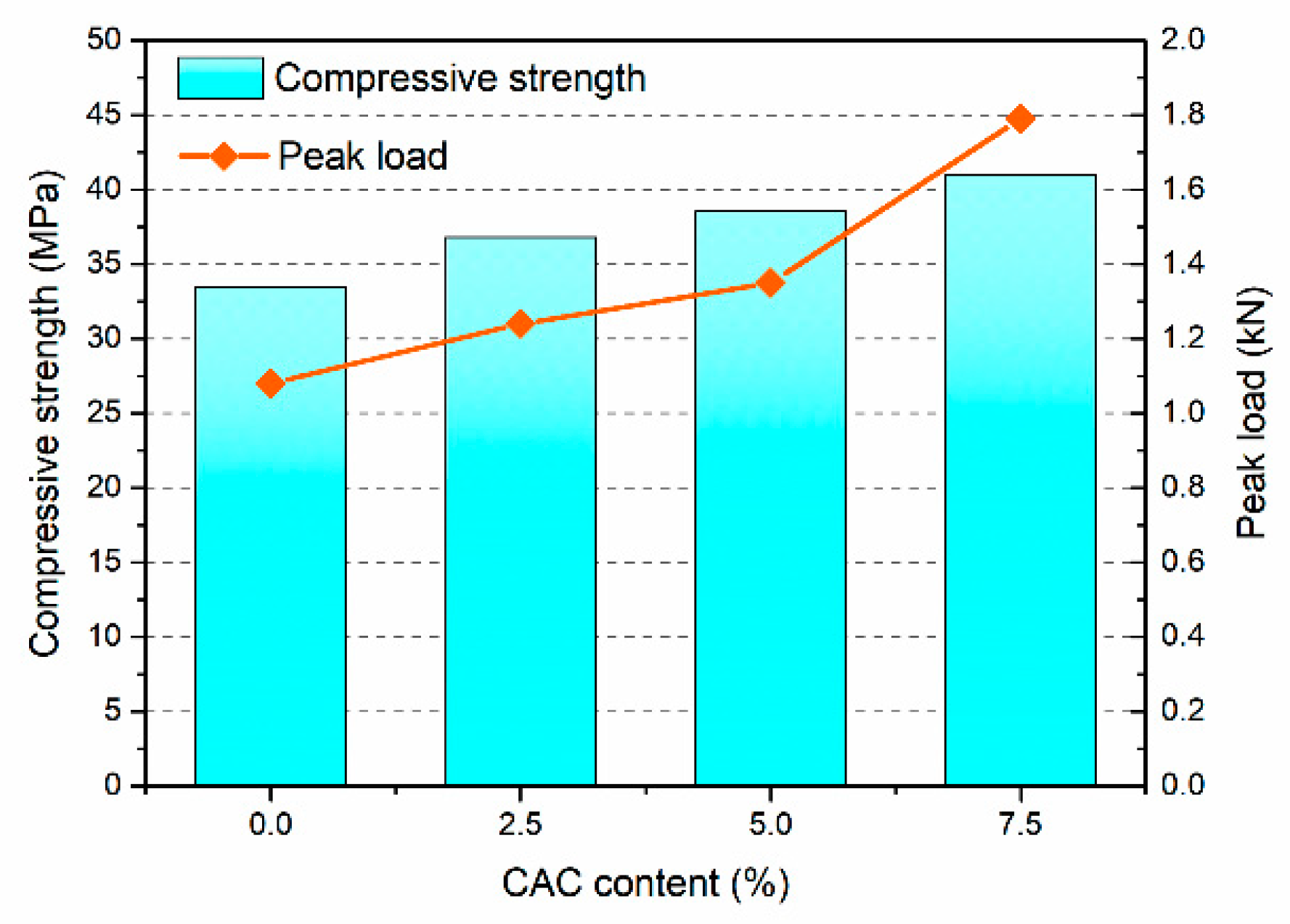Mechanical and Fracture Properties of Fly Ash Geopolymer Concrete Addictive with Calcium Aluminate Cement
Abstract
:1. Introduction
2. Materials and Methods
2.1. Material
2.2. Specimen Preparation
2.3. Compressive Strength, Splitting Tensile Strength and Elastic Modulus
2.4. Three Point Bending Test
3. Results and Discussion
3.1. Compressive Strength
3.2. Splitting Tensile Strength
3.3. Elastic Modulus
3.4. Fracture Properties
3.4.1. Load-CMOD Curves
3.4.2. Peak Load
3.4.3. Fracture Energy
3.4.4. Effective Fracture Toughness
4. Conclusions
- (1)
- The compressive strength, splitting tensile strength and elastic modulus of FAGC improved with the increase of CAC content, the maximal values of them are 41.02 MPa, 2.91 MPa and 16.93 GPa with the growth of 22.63%, 17.81% and 42.99%, respectively, which are corresponding to the CAC content was equal to 7.5%.
- (2)
- The effect of CAC content on was significant, and it caused a favorable effect on . When the CAC content was equal to 7.5%, the maximal value of is almost 85.8 N/m, which is owing to the initial micro-crack in the C-S-H gels absorbed much more energy.
- (3)
- The value of became higher with increasing of CAC content. Typically, for CAC content of 7.5%, the of FAGC reaches up to a maximal value of 4.27 MPam0.5. Meanwhile, the biggest value of achieves up to 10.1 MPam0.5.
Author Contributions
Funding
Acknowledgments
Conflicts of Interest
References
- Ma, B.; Ma, M.; Shen, X.; Li, X.; Wu, X. Compatibility between a polycarboxylate superplasticizer and the belite-rich sulfoaluminate cement: Setting time and the hydration properties. Constr. Build. Mater. 2014, 51, 47–54. [Google Scholar] [CrossRef]
- Jindal, B.B. Investigations on the properties of geopolymer mortar and concrete with mineral admixtures: A review. Constr. Build. Mater. 2019, 227, 116644. [Google Scholar] [CrossRef]
- Davidovits, J. Geopolymers: inorganic polymeric new materials. J. Therm. Anal. Calorim. 1991, 37, 1633–1656. [Google Scholar] [CrossRef]
- Sarker, P.K.; Kelly, S.; Yao, Z. Effect of fire exposure on cracking, spalling and residual strength of fly ash geopolymer concrete. Mater. Design 2014, 63, 584–592. [Google Scholar] [CrossRef]
- Ma, C.-K.; Awang, A.Z.; Omar, W. Structural and material performance of geopolymer concrete: A review. Constr. Build. Mater. 2018, 186, 90–102. [Google Scholar] [CrossRef]
- Mastali, M.; Kinnunen, P.; Dalvand, A.; Mohammadi Firouz, R.; Illikainen, M. Drying shrinkage in alkali-activated binders—A critical review. Constr. Build. Mater. 2018, 190, 533–550. [Google Scholar] [CrossRef]
- Zhang, J.; Shi, C.; Zhang, Z.; Ou, Z. Durability of alkali-activated materials in aggressive environments: A review on recent studies. Constr. Build. Mater. 2017, 152, 598–613. [Google Scholar] [CrossRef]
- Li, X.; Ma, X.; Zhang, S.; Zheng, E. Mechanical Properties and Microstructure of Class C Fly Ash-Based Geopolymer Paste and Mortar. Materials 2013, 6, 1485–1495. [Google Scholar] [CrossRef] [Green Version]
- Nath, P.; Sarker, P.K. Use of OPC to improve setting and early strength properties of low calcium fly ash geopolymer concrete cured at room temperature. Cement Concrete Comp. 2015, 55, 205–214. [Google Scholar] [CrossRef]
- Kusbiantoro, A.; Nuruddin, M.F.; Shafiq, N.; Qazi, S.A. The effect of microwave incinerated rice husk ash on the compressive and bond strength of fly ash based geopolymer concrete. Constr. Build. Mater. 2012, 36, 695–703. [Google Scholar] [CrossRef]
- Adak, D.; Sarkar, M.; Mandal, S. Structural performance of nano-silica modified fly-ash based geopolymer concrete. Constr. Build. Mater. 2017, 135, 430–439. [Google Scholar] [CrossRef]
- Okoye, F.N.; Prakash, S.; Singh, N.B. Durability of fly ash based geopolymer concrete in the presence of silica fume. J. Clean. Prod. 2017, 149, 1062–1067. [Google Scholar] [CrossRef]
- Criado, M.; Palomo, A.; Fernández-Jiménez, A. Alkali activation of fly ashes. Part 1: Effect of curing conditions on the carbonation of the reaction products. Fuel 2005, 84, 2048–2054. [Google Scholar] [CrossRef]
- Vafaei, M.; Allahverdi, A. Influence of calcium aluminate cement on geopolymerization of natural pozzolan. Constr. Build. Mater. 2016, 114, 290–296. [Google Scholar] [CrossRef]
- Hewlett, P. Calcium Aluminate Cements A2. In Lea’s Chemistry of Cement and Concrete, 4th ed.; Butterworth-Heinemann: Oxford, UK, 1998; pp. 713–782. [Google Scholar]
- Scrivener, K. Calcium Aluminate Cements. In Advanced Concrete Technology; Newman, J., Choo, B.S., Eds.; Butterworth-Heinemann: Oxford, UK, 2003; pp. 1–31. [Google Scholar]
- Zhang, J.; Li, G.; Yang, X.; Ren, S.; Song, Z. Study on a high strength ternary blend containing calcium sulfoaluminate cement/calcium aluminate cement/ordinary Portland cement. Constr. Build. Mater. 2018, 191, 544–553. [Google Scholar] [CrossRef]
- Juenger, M.C.G.; Winnefeld, F.; Provis, J.L.; Ideker, J.H. Advances in alternative cementitious binders. Cement Concrete Res. 2011, 41, 1232–1243. [Google Scholar] [CrossRef]
- Hidalgo, A. Microstructure development in mixes of calcium aluminate cement with silica fume or fly ash. J. Therm. Anal. Calorim. 2009, 96, 335–345. [Google Scholar] [CrossRef]
- Matusinović, T.; Kurajica, S.; Šipušić, J. Porosity-strength relation in calcium aluminate cement materials. Cement Concrete Res. 2003, 33, 1801–1806. [Google Scholar] [CrossRef]
- Duxson, P.; Fernández-Jiménez, A.; Provis, J.L.; Lukey, G.C.; Palomo, A.; Deventer, J.S.J.V. Geopolymer technology: the current state of the art. J. Mater. Sci. 2007, 42, 2917–2933. [Google Scholar] [CrossRef]
- Arbi, K.; Palomo, A.; Fernández-Jiménez, A. Alkali-activated blends of calcium aluminate cement and slag/diatomite. Ceram. Int. 2013, 39, 9237–9245. [Google Scholar] [CrossRef]
- Reig, L.; Soriano, L.; Borrachero, M.V.; Monzó, J.; Payá, J. Influence of calcium aluminate cement (CAC) on alkaline activation of red clay brick waste (RCBW). Cement Concrete Comp. 2016, 65, 177–185. [Google Scholar] [CrossRef]
- Cao, Y.-F.; Tao, Z.; Pan, Z.; Wuhrer, R. Effect of calcium aluminate cement on geopolymer concrete cured at ambient temperature. Constr. Build. Mater. 2018, 191, 242–252. [Google Scholar] [CrossRef]
- Bai, C.; Colombo, P. Processing, properties and applications of highly porous geopolymers: A review. Ceram. Int. 2018, 44, 16103–16118. [Google Scholar] [CrossRef]
- Ministry of Construction of the People’s Republic of China. JGJ 52-2006 Standard for Technical Requirements and Test Method of Sand and Crushed Stone (or Gravel) for Ordinary Concrete; China Standard Press: Beijing, China, 2006.
- Ma, H.; Li, Z. Microstructures and mechanical properties of polymer modified mortars under distinct mechanisms. Constr. Build. Mater. 2013, 47, 579–587. [Google Scholar] [CrossRef]
- Ministry of Construction of the People’s Republic of China. GBT 50081-2002, Standard for Test Method of Mechanical Properties on Ordinary Concrete; China Standard Press: Beijing, China, 2012.
- Recommendation, R.D. Determination of the fracture energy of mortar and concrete by means of three-point bend tests on notched beams. Mater. Struct. 1985, 18, 285–290. [Google Scholar]
- Nath, P.; Sarker, P.K. Fracture properties of GGBFS-blended fly ash geopolymer concrete cured in ambient temperature. Mater. Struct. 2017, 50, 32. [Google Scholar] [CrossRef]
- Temuujin, J.; van Riessen, A.; Williams, R. Influence of calcium compounds on the mechanical properties of fly ash geopolymer pastes. J. Hazard. Mater. 2009, 167, 82–88. [Google Scholar] [CrossRef]
- Yip, C.K.; Lukey, G.C.; van Deventer, J.S.J. The coexistence of geopolymeric gel and calcium silicate hydrate at the early stage of alkaline activation. Cement Concrete Res. 2005, 35, 1688–1697. [Google Scholar] [CrossRef]
- Mehta, A.; Siddique, R. Properties of low-calcium fly ash based geopolymer concrete incorporating OPC as partial replacement of fly ash. Constr. Build. Mater. 2017, 150, 792–807. [Google Scholar] [CrossRef]
- Ding, Y.; Dai, J.-G.; Shi, C.-J. Mechanical properties of alkali-activated concrete: A state-of-the-art review. Constr. Build. Mater. 2016, 127, 68–79. [Google Scholar] [CrossRef] [Green Version]
- American Concrete Institute. ACI 318-14 Building Code Requirements for Structural Concrete and Commentary; ACI: Farmington Hills, MI, USA, 2014. [Google Scholar]
- Němeček, J.; Šmilauer, V.; Kopecký, L. Nanoindentation characteristics of alkali-activated aluminosilicate materials. Cement Concrete Comp. 2011, 33, 163–170. [Google Scholar] [CrossRef]
- Fernandez-Jimenez, A.M.; Palomo, A.; Lopez-Hombrados, C. Engineering properties of alkali-activated fly ash concrete. ACI Mater. J. 2006, 103, 106–112. [Google Scholar]
- Nath, P.; Sarker, P.K. Flexural strength and elastic modulus of ambient-cured blended low-calcium fly ash geopolymer concrete. Constr. Build. Mater. 2017, 130, 22–31. [Google Scholar] [CrossRef]
- Hardjito, D.; Wallah, S.E.; Sumajouw, D.M.J.; Rangan, B.V. The Stress-Strain Behaviour of Fly Ash-Based Geopolymer Concrete; AA Balkema Publishers: Leiden, The Netherlands, 2004; pp. 831–834. [Google Scholar]
- Lee, N.K.; Lee, H.K. Setting and mechanical properties of alkali-activated fly ash/slag concrete manufactured at room temperature. Constr. Build. Mater. 2013, 47, 1201–1209. [Google Scholar] [CrossRef]
- Xu, S.; Reinhardt, H.W. Determination of double-Kcriterion for crack propagation in quasi-brittle fracture, Part II: Analytical evaluating and practical measuring methods for three-point bending notched beams. Int. J. Fracture 1999, 98, 151–177. [Google Scholar] [CrossRef]
- Hu, S.; Fan, B. Study on the bilinear softening mode and fracture parameters of concrete in low temperature environments. Eng. Fract. Mech. 2019, 211, 1–16. [Google Scholar] [CrossRef]
- Tada, H.; Paris, P.; Irwin, G. The Stress Analysis of Cracks Handbook; ASME Press: New York, NY, USA, 2000. [Google Scholar]










| Materials | SiO2 | Al2O3 | Fe2O3 | CaO | MgO | K2O | Na2O | SO3 |
|---|---|---|---|---|---|---|---|---|
| FA | 49.37 | 32.14 | 5.20 | 4.77 | 1.80 | 1.59 | 1.30 | 1.03 |
| CAC | 7.09 | 49.67 | 1.99 | 36.69 | 0.367 | 0.56 | 0.12 | 0.69 |
| Mix | Fly Ash | NaOH | Na2SiO3 | Fine Aggregate | Coarse Aggregate | CAC | Water | sg |
|---|---|---|---|---|---|---|---|---|
| M0 | 563.54 | 44.51 | 124.55 | 732.60 | 599.40 | 0 | 132.43 | 8.45 |
| M1 | 549.45 | 44.51 | 124.55 | 732.60 | 599.40 | 14.09 | 132.43 | 8.45 |
| M2 | 524.09 | 44.51 | 124.55 | 732.60 | 599.40 | 28.18 | 132.43 | 8.45 |
| M3 | 521.27 | 44.51 | 124.55 | 732.60 | 599.40 | 42.26 | 132.43 | 8.45 |
| Mix | CAC Content (%) | Compressive Strength (MPa) | Splitting Tensile Strength (MPa) | Elastic Modulus (GPa) |
|---|---|---|---|---|
| M-0 | 0 | 33.45 | 2.47 | 11.84 |
| M-1 | 2.5 | 36.79 | 2.59 | 14.79 |
| M-2 | 5 | 38.53 | 2.84 | 15.44 |
| M-3 | 7.5 | 41.02 | 2.91 | 16.93 |
| Spectrum | Ca | Na | Al | Si | O | Ca/Na | Si/Al |
|---|---|---|---|---|---|---|---|
| S1 | 0.32 | 4.69 | 7.64 | 14.35 | 60.08 | 0.07 | 1.88 |
| S2 | 1.07 | 4.08 | 9.05 | 14.75 | 61.71. | 0.26 | 1.62 |
| S3 | 1.42 | 3.47 | 13.51 | 15.44 | 60.48 | 0.41 | 1.14 |
| S4 | 2.08 | 3.42 | 11.37 | 11.34 | 60.49 | 0.61 | 1.00 |
| Mix | CAC Content (%) | ||||
|---|---|---|---|---|---|
| M-0 | 0 | 621.1 | 1079 | 0.0695 | 36.5 |
| M-1 | 2.5 | 817.6 | 1236 | 0.06824 | 42.3 |
| M-2 | 5 | 862.4 | 1353.6 | 0.04853 | 44.1 |
| M-3 | 7.5 | 1259.6 | 1788.4 | 0.0377 | 44.4 |
© 2019 by the authors. Licensee MDPI, Basel, Switzerland. This article is an open access article distributed under the terms and conditions of the Creative Commons Attribution (CC BY) license (http://creativecommons.org/licenses/by/4.0/).
Share and Cite
Wang, Y.; Hu, S.; He, Z. Mechanical and Fracture Properties of Fly Ash Geopolymer Concrete Addictive with Calcium Aluminate Cement. Materials 2019, 12, 2982. https://doi.org/10.3390/ma12182982
Wang Y, Hu S, He Z. Mechanical and Fracture Properties of Fly Ash Geopolymer Concrete Addictive with Calcium Aluminate Cement. Materials. 2019; 12(18):2982. https://doi.org/10.3390/ma12182982
Chicago/Turabian StyleWang, Yamin, Shaowei Hu, and Zhen He. 2019. "Mechanical and Fracture Properties of Fly Ash Geopolymer Concrete Addictive with Calcium Aluminate Cement" Materials 12, no. 18: 2982. https://doi.org/10.3390/ma12182982




